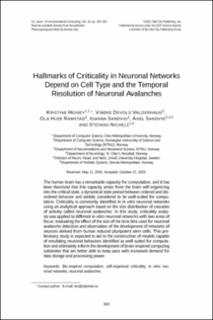| dc.contributor.author | Heiney, Kristine | |
| dc.contributor.author | Valderhaug, Vibeke Devold | |
| dc.contributor.author | Huse Ramstad, Ola | |
| dc.contributor.author | Sandvig, Ioanna | |
| dc.contributor.author | Sandvig, Axel | |
| dc.contributor.author | Nichele, Stefano | |
| dc.date.accessioned | 2022-02-08T14:45:41Z | |
| dc.date.available | 2022-02-08T14:45:41Z | |
| dc.date.created | 2021-05-20T16:04:01Z | |
| dc.date.issued | 2021 | |
| dc.identifier.citation | International Journal of Unconventional Computing. 2021, 16 (4), 303-326. | en_US |
| dc.identifier.issn | 1548-7199 | |
| dc.identifier.issn | 1548-7202 | |
| dc.identifier.uri | https://hdl.handle.net/11250/2977783 | |
| dc.description.abstract | The human brain has a remarkable capacity for computation, and it has been theorized that this capacity arises from the brain self-organizing into the critical state, a dynamical state poised between ordered and dis- ordered behavior and widely considered to be well-suited for computation. Criticality is commonly identified in in vitro neuronal networks using an analytical approach based on the size distribution of cascades of activity called neuronal avalanches. In this study, criticality analysis was applied to different in vitro neuronal networks with two areas of focus: evaluating the effect of the size of the time bins used for neuronal avalanche detection and observation of the development of networks of neurons derived from human induced pluripotent stem cells. This pre- preliminary study is expected to aid in the construction of models capable of emulating neuronal behaviors identified as well-suited for computation and ultimately inform the development of brain-inspired computing substrates that are better able to keep pace with increased demand for data storage and processing power. | en_US |
| dc.description.sponsorship | This work was conducted as part of the SOCRATES project, which is partially funded by the Norwegian Research Council (NFR) through their IKT PLUSS research and innovation action on information and communication technologies under the project agreement 270961. | en_US |
| dc.language.iso | eng | en_US |
| dc.publisher | Old City Publishing | en_US |
| dc.relation.ispartofseries | International Journal of Unconventional Computing;Volume 16, Number 4 (2021) | |
| dc.relation.uri | https://www.oldcitypublishing.com/journals/ijuc-home/ijuc-issue-contents/ijuc-volume-16-number-4-2021/ijuc-16-4-p-303-326/ | |
| dc.subject | Bio-inspired computation | en_US |
| dc.subject | Self-organized criticality | en_US |
| dc.subject | In vitro neuronal networks | en_US |
| dc.subject | Neuronal avalanches | en_US |
| dc.title | Hallmarks of Criticality in Neuronal Networks Depend on Cell Type and the Temporal Resolution of Neuronal Avalanches | en_US |
| dc.type | Peer reviewed | en_US |
| dc.type | Journal article | en_US |
| dc.description.version | publishedVersion | en_US |
| cristin.ispublished | true | |
| cristin.fulltext | original | |
| cristin.qualitycode | 1 | |
| dc.identifier.doi | https://www.oldcitypublishing.com/journals/ijuc-home/ijuc-issue-contents/ijuc-volume-16-number-4-2021/ | |
| dc.identifier.cristin | 1911123 | |
| dc.source.journal | International Journal of Unconventional Computing | en_US |
| dc.source.volume | 16 | en_US |
| dc.source.issue | 4 | en_US |
| dc.source.pagenumber | 303-326 | en_US |
| dc.relation.project | Norges forskningsråd: 270961 | en_US |
| dc.relation.project | Norges forskningsråd: 286558 | en_US |
